Adiantum raddianum



Stemless / Acaulescent
A plant that has no stems, when the flower stalks and leaf blades are produced from ground level.
Clumping
A plant that when multiplies forms a clump.This soft fern has suckering short rhizomes that form a clump with wiry-like branched triangular-shaped fronds. The fronds have small light to dark green leaflets are delicate and semi pendant and the fertile fronds appear during early summer.
Adiantum raddianum C. Presl. is naturally found in the tropical and sub-tropical Central to South America from Mexico to Venezuela, Brazil and Argentina. It is also found in the Caribbean from Costa Rica to Nicaragua. It grows in a semi shaded moist, humid positions along creeks in rock crevices or in forested gullies commonly associated with rock outcrops appearing from sea level to an elevation of 4,400 m (14,436 ft). It has also naturalised in the Pacific Islands and is regarded as invasive in Hawaii and French Polynesia where it replaces native species. It prefers well drained but moist, moderately fertile sand-stony soil that is acidic to alkaline with a pH range from 5.5 to 8.0. It grows in damp semi-shaded wind protected humid positions and is frost, dry wind and drought tender with a preferred minimum winter temperature of 7.2ºC (45ºF).
Common Maidenhair is grown for its soft lacy appearance and its cascading habit. It is commonly cultivated as a potted specimen or planted in moist shady rockeries and as an understorey in gully plantings. It is also planted around water features or used in cottage gardens. In cool climates it is used as a glasshouse specimen or as a house plant. It is very vigorous and establishes in 1 to 2 years and under ideal conditions it will spread by spores. Once established it has a medium water requirement, (Scale: 2-drops from 3) and requires reliable soil moisture and misting to increase humidity.
I.D. 427
UK hardiness zone H1b
Climate zones 8 - 24
USDA Zone 10-12
Adiantum (ad-ee-AN-tum) raddianum (rah-dee-AH-num)
Etymology
Genus: - Greek - Adiantum– from ‘adiantos’ meaning (un-wetted) referring to how the leaves shed water.
Species: - raddianum – named after Giuseppe Raddi (1770-1829) who was an Italian botanist and curator at the Museum of Natural History of Florence and one of the first Europeans to explore and document the flora of Central and South America.
Cultivars
'Charlotte Parvifolium'
This upright fern has slender dark branched stems that are topped with bright green delicate foliage. It is used as a potted plant or in moist rockeries.
'Frangrantissimum'
This tender fern has very fine triangular foliage that is 3 to 4 pinnate with overlapping rounded lobed segments. It requires a humid wind protected position in a bright filtered light and dislikes being moved or root disturbance. It can grow to 750 mm (30 in) tall by 1 m (3 ft) wide in 10 years and is planted ain shaded damp rockeries or as a glasshouse specimen.
'Fritz Luthi'
This clump forming evergreen fern has a creeping rhizome and grows to 600 mm (2 ft) tall and wide. It has arching, triangular 3- or 4-pinnate fronds with lobed triangular overlapping segments. It is commonly cultivated as a potted specimen or used in damp rockeries.
'Longton's Pride'
This plant is upright and spreading with brown stems that are heavily covered in light green foliage that has a ruffled appearance. It is used in shaded patio pots or in moist protected gully settings.
Common names; Delta Maidenhair Fern, Common Maidenhair, Bush Maidenhair

Central America, Caribbean, South America
Pteridaceae (TE-ri-de-AY-see-ee)
(Adiantaceae)
The plants in this family are represented by three major evolutionary lines (adiantoids, pteroides and cheilanthoids). They are terrestrial or grow on rocks at a range of from temperate to tropical regions.
Distribution
The plants are rhizomatous and are normally found in damp areas along riverbanks and in rainforests amongst rocks.
Diagnostic Features
These plants have a short or long creeping rhizome that branch freely and are covered in yellowish to reddish brown scales with hard stipes that are purple to black.
The fronds are semi-erect to erect or pendent and are pinnate to quadripinnate in shape.
The pinnae or pinnules are membranous, asymmetrically and glabrous or hairy. The sori is elongated, reniform or crescent-shaped and have a false indusium (lack an indusia) or are protected by a reflex or revolute leaf margin.
Note:
These delicate looking ferns are hardy and some species are drought resistant and many are popular for pot cultivation. There are 40 genera and 1000+ species.
This plant tolerates between USDA zones 10a to 12a and grows to 50 cm (1 ft 6 in)
Fahrenheit 30º to 55º F
These temperatures represent the lowest average.
Celsius -1.1º to 12.7º C

Attention
This plant was last revised on the 8/10/2019
The information displayed on this plant is based on research conducted in our horticultural library and from reliable online resources. We also make observations of the plant that we photograph, and all care is taken to ensure the details are correct.
All photographs and data are covered by copyright. Apart from any fair dealing for the purpose of private study, research, reference or review, as permitted under the Copyright Act, no part including images and text may be reproduced by any means without written permission. The information presented in the map is only indicative and may contain errors and omissions. All inquiries should be addressed to sales@plantfile.com attention Peter Kirkland.

Compound
The leaf that is divided into separate units (leaflets).
Pinnate
A compound leaf that ends in a single or double leaves.
Basal
When the leaves grow from the base of the plant or radically from the root-shoot point.
Crenate
A leaf margin that is saw toothed with the teeth being rounded.The pinnate triangular fronds are up to 600 mm (2 ft) long with a black petiole up to 100 mm (4 in) long. They are 3-pinnate consist of numerous cuneate segments that are up to 13 mm (½ in) wide with minutely toothed or lobed margins. They are pale green when young light becoming dark green as they mature.


Sori
A patch of fructification on the back of the fronds of ferns.| Jan | Feb | Mar | Apr | May | Jun |
| Jul | Aug | Sep | Oct | Nov | Dec |
The fertile fronds have sporangia that are reniform (kidney shape) with 1 to 4 sori per pinnule and are deeply embedded on the underside of the lobe.

Sporangium
It is a cell or structure where the spores are produced on the undersides of fronds."| Jan | Feb | Mar | Apr | May | Jun |
| Jul | Aug | Sep | Oct | Nov | Dec |
Generally the spores are produced in the sporangium during the sporophyte stage of the fern life cycle in rows on the back of the fertile frond. The spores are very small (like fine dust) and are released from the sori when mature.
Common Maidenhair is grown for its soft lacy appearance and its cascading habit. It is commonly cultivated as a potted specimen or planted in moist shady rockeries and as an understorey in gully plantings. It is also planted around water features or used in cottage gardens. In cool climates it is used as a glasshouse specimen or as a house plant. It is very vigorous and establishes in 1 to 2 years and under ideal conditions it will spread by spores.
Note:
This plant is susceptible to Fungal Leaf Spots, Grey Mold and Leaf Nematodes.
Adiantum raddianum
When grown indoors Maiden Hair Ferns require a minium night-time temperature of 10º C (50º F) and prefer high humidity around 60 % which can be achieved with misting the surrounding air regularly. The plants do well in terrariums or placed in bathrooms in bright indirect light.
Re-pot only when necessary, as the plants prefer the roots to be crowded and water regularly during summer and reduce watering during winter. Do not allow the soil to become boggy or dry out.
FERNS
General cultural requirements for ferns
Temperature
The ideal temperature required for ferns ranges from 15.5º to 22º C (60º to 70º F); above and below these temperatures the ferns tend to suffer.
Light
Naturally a fern receive bright dappled light and for successful growth around a home bright indirect light is preferred. Ferns do poorly if grown in the shade.
Water
Ferns require constantly moist, well drained soils but not wet or waterlogged as this promotes rot. Ferns like the water to pass by the roots regularly.
Humidity
Ferns need a humid environment and do poorly in dry air. Humidity may be maintained for potted plants by regular misting of the fronds or by placing the container above a saucer filled with water. In the outdoors maintain moist soils or in hot weather outside spray the area with a garden hose for a short period regularly.
Re-potting
Re-pot ferns when the roots have filled the container, preferable during spring and use a well drained loam based soil mix with added leaf mould. When planting, be careful not to bury the crown of the plant.
When fertilising, ferns prefer a little and regular liquid fertiliser during the growing period and this will improve pale fronds and weak growth.
Soil
Generally ferns prefer a heaver well drained soil type with ample organic matter tending acidic. Sandy soil types require regular mulching and heavy clay soils require the addition of gypsum and organic matter in conduction with cultivation to make it more friable. They will tolerate most soil types including granite or basalt based and some species are found in limestone base soils. All require organic material and moisture.
Place spores on sterilised sphagnum moss or peat moss, bricks or terracotta pot base then cover with glass and keep moist. 4 to 6 weeks until prothalli appears. True fronds appear between 6 - 12 months after sowing. Division during the growing period, cut the rhizomes in to lengths and plant apex upwards, apply bottom heat and keep moist.
Rhizomes (General)
A rhizome is a stem that grows horizontally either below or on the surface of the soil with the shoots growing vertically as in bamboo and many grasses. The stems are composed of nodes and inter nodes giving it a segmented appearance.
Propagation is normally carried out by division during spring and autumn, by cutting the rhizome into sections each with at least one node. Placed on a moist bed or slightly buried and kept warm will produce roots and shoots from the nodes.
PEST
NAME
Looper Caterpillars
Various Looper Caterpillar Species
ORDER
Lepidoptera
FAMILY
Noctuidae
Description of the Pest
The looper is so-called because of the larvae's characteristic "looping" movement: the back legs move forward behind the front legs, causing the body to arch into an inverted "U" shape. They vary in colour and size; Brown Looper (Lophodes sinistraria) can grow to 50mm long, glossy black with yellowish bands then maturing to brown and found in coastal sub-tropical regions.
Green Wattle Looper (Thalaina species) adult is a small white moth with a wing span of 40mm and the lava is a slender green caterpillar with a rounded head. It is commonly found on ferny leaves Acacia species and when it is not feeding it takes up an erect position imitating a twig growing at an angle. It is difficult to detect and normally not requiring control.
Grevillea Lopper (Oenochroma vinaria) is a slender caterpillar that is greyish with orange bands and has two thorn-like projections on its back towards the head that it uses in a defence position. It is hairless with mottled orange colouring and grows to 80mm long. The adult moth (pink belly moth) has a wing span up to 60mm across and is pinkish.
Brown Looper (Lophodes sinistraria) are black with yellowish bands at first maturing to brown growing to 50mm long. It is a solitary feeder eating mature leaves and are found in tropical to sub tropical regions.
Appearance and Distribution of the Pest
Many species are found throughout Australia from tropical to temperate regions.

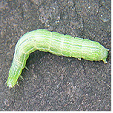
Life Cycle
These insects have a Holometabolous life cycle, ie. When metamorphosis is observed during the pupal stage.
Period of Activity
Most active during the warmer months the larva feed generally in the early morning or in the evening. Caterpillars are also active during cloudy days.
Damage Caused
Larvae are voracious feeders, skeletonising leaves or stripping them to the midrib preferring new growth.. Certain species feed solitary while others in groups.
The Grevillea Lopper feeds solitary or in groups defoliating small areas in species such as Lambertia and Grevillea.
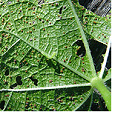
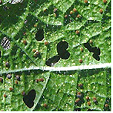
Susceptible Plants
A wide range of native and exotic plants are attacked, depending on the species of looper. Plants with soft-textured foliage (eg vegetables, some indoor plants) are preferred. The Brown Looper is found on Acmena smithii, Waterhousea floribunda and Macadamia species.
Tropaeolum and Calendula species are attacked by the Cabbage Looper (Trichoplusia ni), which feeds on the leaves and flowers.Tropaeolum species are also attacked by the caterpillar (Pieris rapae), which eats the foliage.
Cultural Control
Small numbers may be removed by hand.
Biological Control
Birds and other predators reduce numbers.
Chemical Control
The plant may be sprayed using Carbaryl. During heavy infestations this method is effective.
Note
Always read the label for registration details and direction of use prior to application of any chemicals.
PEST
NAME
Slugs and Snails
Various Snails Species
Description of the Pest
Slugs and snails are land molluscs. Snails produce an external spiral shell; slugs do not. The common garden snail Helix asperasa, grows up to 25 mm, long. Its body is slimy, broad, elongated and greyish, with two pairs of reticulated tentacles, with eyes at the ends of the longer pair. The mouth parts of snails and slugs contain a file-like organ known as the radula, which is used to rasp away at the host plant's tissue. Movement of the animal is by a muscular sliding movement, along a slippery trail of mucous; this solidifies on exposure to the air (typically described as a "silvery trail").
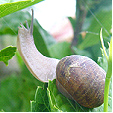
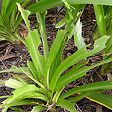
Appearance and Distribution of the Pest
Slugs and snails occur world-wide. Slugs tend to be more prevalent in heavier soil types.
Life Cycle
These insects have a Hemimetabolous life cycle, ie. When the immature nymphs resemble the adults.
Snail eggs are laid in moist soil, 20-40mm deep; eggs are white, spherical and appear in clusters of 30-100. Under favourable conditions, eggs hatch in 2-3 weeks. Newly emerged snails resemble tiny adults. When the weather is cold and dry, snails seal themselves into their shells where they survive, dormant, for 1-3 years.
Period of Activity
More active during the warmer months, although some species may remain active throughout the year.
Damage Caused
Native Australian slugs and snails are not commercial pests. Introduced species chew holes in foliage or skeletonise leaves; some plants may be completely defoliated plants; tubers and seedlings may be completely eaten. Slugs and snails feed mainly at night, especially after rain or watering; they shelter in cool, moist locations during the day. When the weather is dry, snails seal themselves into their shells with a mucous membrane, where they survive, dormant, for 1-3 years. Some species may consume up to one third of their body weight each day.
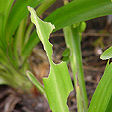
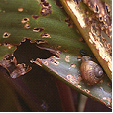
Susceptible Plants
A wide range of leafy plants, including ground crops, potatoes, tubers, leafy vegetables and seedlings.
Fern species are attacked causing serious damage. New fronds are repetitively eaten causing the plant to become stunted. Attacks are normally more severe during wet periods during which time control measures should be taken.
Morinda citrifolia is attacked by the Giant African Snail (Achatina fulica) which defoliates trees.
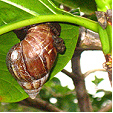

Cultural Control
Remove possible hiding places and avoid overhead watering to reduce humidity. Cultivate soil regularly; in commercial situations, allow the soil to remain fallow for one season to reduce numbers. Domestic infestations may be removed by hand. Traps may be created by inverting small pots near where snails and slugs are feeding; they will gather in these shelters during the day, and may be collected and destroyed. The popular Australian "beer trap" consists of a vertically-sided container, sunk into the ground and filled with beer, which intoxicates and drowns the snails.
Biological Control
Natural predators such as birds, frogs, and lizards reduce numbers, but do not provide effective control. Orchardists have used running ducks to control snails with some success.
Chemical Control
Commercial baits - molluscicides - made from methiocarb or metaldehyde are effective when used in combination with sanitation. Their effectiveness varies according to soil and weather conditions; it is generally recommended to avoid watering after application.
Note
Always read the label for registration details and direction of use prior to application of any chemicals.
PEST
NAME
Whitefly, Snow flies
Various Whitefly Species
ORDER
Hemiptera
FAMILY
Aleyrodidae
Description of the Pest
This is a small sap sucking moth-like insect up to 3mm long with winged adults that have a covering of fine white powder, hence the common name. The wings are folded flat over the body and males live for one month and females live up to three months. The eggs are laid on the underside of the leaf and the wingless nymphs are immobile, flattened-round scale -like with a fringe of waxy filaments. The nymphs are translucent to greenish, congregating on young plant tissue and both adults and nymphs suck sap and producing honeydew.
There are several species such as Ash whitefly (Siphoninus phillyreae), Tobacco whitefly (Bemesia tabaci), Silverleaf whitefly and Spiralling whitefly (Aleurodicus disperses)
Greenhouse whitefly (Trialeurodes vaporariorum)
This species of whitefly normally grow to 2mm long with two pairs of wings. Their colour is due to a covering of a fine white wax and the insect has a white-moth appearance. If disturbed the insects swarm and resettle on the plant quickly. The first nymphal stage is mobile and the later stage is scale-like with fine waxy marginal hairs. These nymphal stages produce honeydew, which encourages sooty mould. It is a persistent pest commonly found in glasshouses.
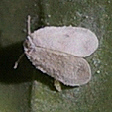 Adult
Adult 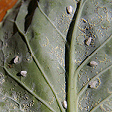 Appearance under the leaf
Appearance under the leaf
The Hakea Whitefly (Synaleurodicus hakeae) is a small, moth-like up to 0.15mm wide with wings that have a powdery coating and produce flattened scale-like nymphs. Both adult and nymph gather together in colonies and suck sap.
Appearance and Distribution of the Pest
The eggs are laid during the spring and the adults tend to stay on the underside of the leaf until disturbed, when they fly in mass and may infect other plants. Many plants are only susceptible to this insect when cultivated under glass.
Life Cycle
This insect has a Hemimetabolous life cycle, ie. When the immature nymphs resemble the adults.
White flies have a gradual metamorphosis, egg and four nymphal stages. One generation occurs from three to eight weeks and is dependant on the current weather. Hundreds of eggs are deposited on the underside of leaves in arch or circles each with a short stalk.
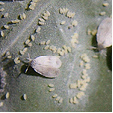 Eggs laid in a pattern
Eggs laid in a pattern 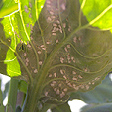 Eggs laid in a pattern
Eggs laid in a pattern
After hatching the first nymphal stage wanders around on the leaf surface for several days. Then selects a place to suck sap where it goes through all nymphal stages emerging as an adult after the fourth stage.
Period of Activity
This peat is found from tropical to temperate regions and is most active during warm weather. It is difficult to predict an infestation, as some years it is severe and other years it is absent. In glasshouse conditions it is often a problem and may extend outside the normal period of activity. They overwinter in the egg stage or find sheltered places to hide.
Damage Caused
Affected plants have leaves with yellowish to white mottling on the upper surface or with shiny secretions on new shoots or on the underside. Heavy infestations cause leaves to wilt and sooty mould to appear on the honeydew. Plant looses vigour and in some cases die.
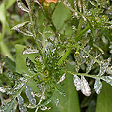
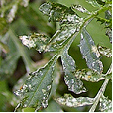 Tagetes erecta
Tagetes erecta
Susceptible Plants
Whiteflies attack a wide range of plants affected by this insect, including Abutilon, Boronia, Hibiscus and Fuchsia species. Citrus, Vegetables, Ferns and certain weed species are venerable. Australian native plants are also attacked, such as the Hakea species.
Greenhouse whitefly (Trialeurodes vaporariorum) attacks a wide range of ornamental plants, weeds and vegetables including; Phaseolus (beans), Lycopersicon (tomatoes), potatoes, Cucumis (cucurbits), Lactuca (lettuce), Dendranthema (Chrysanthemum), Dahlia and Hibiscus species.
Several ferns, including Adiantum, Asplenium, Davallia, Nephrolepis, Onychium, Platycerium and Pteris species are attacked with nymphs congregating on the underside of the fronds, normally causing little damage.
Rhododendron species are attacked by the Rhododendron White Fly (Dialeurodes chittendeni) causing yellowish mottled appearance on the upper surface of the leaf.
Cultural Control
It is difficult to control with out the application of chemicals, though strong jets of water greatly disturb the colonies. Companion plantings with basil or other aromatic plants deters white flies or spray the plants with onion-garlic spray.
In an enclosed environment sticky fly paper can reduce numbers. When the nymphal stage is found an application of white oil will reduce numbers.
Biological Control
A parasitic wasp (Encarsia Formosa) attacks nymphal stages reducing numbers. Other predators include small birds, spiders, ladybirds and there lava, hover flies, damsel flies and mantids.
Chemical Control
Plants may be sprayed with Dimethoate, permethrin, bifenthrin or pirimiphos-methyl, but some insects have immunity to chemicals. The pest may also be sprayed with a mixture of white oil and nicotine sulphate or pyrethrum.
Note
Always read the label for registration details and direction of use prior to application of any chemicals.
DISEASE
NAME
Leaf Spot (General)
Various Leaf Spot Species
Description
There is a wide variety of fungal leaf spots that infect perennials, shrub and trees. Some are specific to the host while others can affect a range of plants.
Symptoms
Generally light brown to purplish or blackish spots appear on the leaf and form concentric rings of fruiting bodies. The spots may leave holes, perforating the leaf or expand with pale green to yellowish margins and when the holes merge the leaf normally dies. There are many different types of leaf spot, some are discussed below.
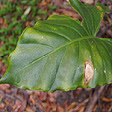 Alocasia species
Alocasia species 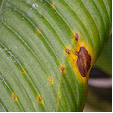
Alternaria Leaf Spot (Alternaria nelumbii) forms a small reddish brown spots that are boarded in light green, and as they develop in size the leaf curls and dies from the margin inwards. Normally occurs on Nelumbo species (water lilies).
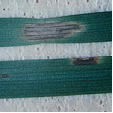 Helminthosporium Disease
Helminthosporium Disease
Helminthosporium Disease (Bipolris species), (Drechslera species) and (Exserophilum species) are responsible for several leaf spots that occur on all Turf Grass species. Generally they form black or white spots that may be faded and produce masses of spores in the thatch during late summer, under humid conditions. The life cycle is short and when conditions are favourable spores are splashed onto the foliage from the thatch, causing wide spread infection. Cynodon dactylon (common couch) is most susceptible and found in bowling or golf greens where it is a serious problem.
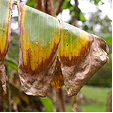 Banana Leaf Spot
Banana Leaf Spot 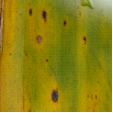
Banana Leaf Spot (Mycosphaerella musicola) is found on many species of banana causing pale yellow streaks on the young leaves to turn brown with dark spots. The leaf then becomes dried, brown and dead commencing from the margins, eventually the leaf dies. Control requires removal of infected foliage or the spraying of a fungicide and fungicides should not be used during the fruiting period.
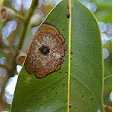
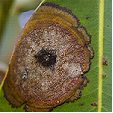 Lophostemon confertus (Brush Box)
Lophostemon confertus (Brush Box)
Leaf Spot on Brush Box (Elsinoe species). This is a casual fungus that attacks the epidermal layer of the leaf, forming circular spots that are up to 25mm across and are often restricted by the main vein. These spots are a dull yellowish brown but can also have purplish patterns. A leaf may have more than one spot develop on its surface and normally appears on scattered leaves throughout the tree. This doesn't affect the vigour of Lophostemon confertus.
Palm Leaf-scab (Graphiola phoeicis) appears as yellow spots and develop into scabs or warts that are outwards hard and dark but with a soft centre with powdery yellowish brown spores. The infected leaves eventually die.
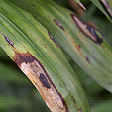 Palm Leaf Spot, Chamaedorea elegans
Palm Leaf Spot, Chamaedorea elegans
Palm Leaf Spot (Pestaloptiopsis species) appears as a small spot with a dark centre on the leaves and affects palms that are growing in shaded humid positions and normally control is not required, though infected fronds should be removed.
Source and Dispersal
Infection source is other contaminated plants and the spores are spread by wind or by splashing water. The fruiting bodies are black spots that appear on the damaged tissue releasing spores.
Favoured Conditions
This fungus prefers a warm humid environment and leafy plants with soft new growth, particularly if they are crowded.
Affected Plants
There are many ornamental and native plants that are hosts to a wide range of fungal leaf spots. Some specific ones are listed below. Plants such as Cornus or Paeonia species are infected by a large variety of leaf spots, while other plants attract a specific leaf spot.
Generally a healthy plant can tolerate fungal leaf spot attack, though it may make the plant look unsightly. In trees and shrubs it is difficult to control and generally not necessary, but in perennials and annuals control may be necessary in order to save the plant.
Acalypha and Arctotis species are infected by up to three leaf spots including (Cercospora acalyphae) and (Ramularia acalyphae) that rarely require control.
Acer species are infected by Purple Eye (Phyllosticta minima) which forms spots with brownish centres and purplish margins causing the death of the leaves.
Acer species are also infected by Tar Spot (Rhytisma acerinum) which forms round black spots that have yellow margins. Not normally seen on cultivated trees, but seen in forests.
Adiantum, Asplenium, Blechnum, Cyathea, Davallia, Nephrolepis, Platycerium, Polypodium and Pteris species are infected by the leaf spot (Pseudocercopora species) which forms circular brown spots on the fronds and heavy infection can defoliate a plant.
Aesculus species are occasionally infected with the leaf spot (Septoria hippocastani) which forms small brown spots.
Agave species are susceptible to the leaf spot (Coniothyrium concentricum), which appear as greyish spots up to 20mm (1in) across with concentric rings and black fruiting bodies. Affected leaves are destroyed as the infection spreads.
Albizia julibrissin is susceptible to the fungal leaf spot (gloeosporium aletridis), which does not normally require control.
Amelanchler, Chaenomeles, Crataegus and Rhaphiolepis species Mespilus germanica are infected by the leaf spot (Fabraea maculata) which may cause considerable damage during wet periods.
Aquilegia species can be infected by three types of Leaf Spot including (Ascochyta aquilegiae), (Cercospora aquilegiae) and (Septoria aquilegiae), normally appearing during humid conditions forming spots on the leaves.
Arbutus species are infected by two leaf spots (Septoria Unedonis) which produces small brown spots on the leaves and (Elsinoe mattirolianum).
Arctostaphylos manzanita is infected by the leave spot (Cryptostictis arbuti) which damages leaves but is not normally detrimental to the shrub.
Aspidistra species are infected by the leaf spot (Colletotrichum omnivorum) causing whitish spots on the leaves and petiole.
Aster species are infected by many leaf spots including (Alternaria species), (Cercosporella cana), ( Ovularia asteris) and (Septoria asteris).
Aucuba species are infected by several leaf spots, usually as a secondary infection after aphid attack. These include (Phyllosticta aucubae) and (Phyllostica aucubae).
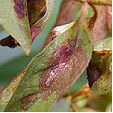
 Azalea
Azalea
Azalea (Rhododendron species) are susceptible to Leaf Scorch (Septoria azalea). This fungal disease forms reddish- brown spots which expand and engulf the leaf, with fruiting bodies appearing in the centre. Infected leaves die, then fall and the branchlets wilt. This problem is more serious during wet periods and may require control using a fungicide.
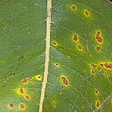 Banksia robur
Banksia robur
Banksia species are infected by several leaf spots causing chlorotic areas that have brown centres and is not normally a major problem for the plant.
Betula species may be infected by the Leaf Spots (Gloeosporium betularum) that forms brown spots with darker margins and (Cylindrosporium betulae) that also forms brown spots with faded indefinite margins.
Bougainvillea species are infected by the leaf spot (Cercosporidium bougainvilleae) which forms rounded spots with dark margins that yellowish ting. Infected leaves die and fall from the plant.
Calendula species are infected by the Leaf Spot (Cercospora calendulae) which rapidly infects the plant spotting the leaves and killing the plant.
Callicarpa species may be infected by the leaf spot (Atractilina callicarpae) forming irregular brownish spot or (Cercospora callicarpae) which can defoliate the plant in subtropical climates.
Campsis species may be infected by several fungal leaf spots including (Phyllosticta tecomae), (Septoria tecomae) and (Cercospora duplicata).
Carpinus species are infected by the leaf spots (Gloeosporium robergei), (Gnomoniella fimbriata) and (Septoria carpinea), all are minor infections not normally requiring control.
Carya species are infected by several leaf spots including (Gnomonia caryae) that infects leaves with irregular reddish spots on the upper surface with corresponding brown spore producing spots on the underside. It also has a secondary spore release that occurs on the dead leaves where it over winters. Other leaf spots include (monochaetia desmazierii) and (Marssonina juglandis).
Ceanothus species are susceptible to the leaf spot (Cercospora ceanothi) and (Phyllosticta ceanothi) both are of minor importance not requiring control.
Celtis species are infected by many leaf spots including (Cercosporella celtidis), (Cylindrosporium celtidis), (Phleospora celtidis) and (Septogloeum celtidis).
Chrysanthemums species are infected by the leaf spot (Septoria species) which forms yellow spots appear toward the edge of the leaves; these become enlarged brownish patches with yellow margins. Damaged areas may converge and in severe attacks and the leaves may fall prematurely or flower production is reduced.
Clematis species are infected by the fungal disease (Ascochyta clematidina) which may cause stem rot or leaf spots that are water soaked areas with reddish margins. The infection spreads from the leaves to the stem causing wilting and eventually girdling the stem killing the plant. There are many fungal leaf spots that infect this plant including (Cercospora rubigo) and (Septoria clematidis)
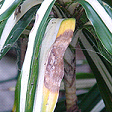 Dracaena deremensis
Dracaena deremensis
Cordyline and Dracaena species may be infected by the leaf spot (Phyllosticta maculicola) which forms small brownish spots that have yellowish margins and has black fruiting bodies that forms coils of spores. These plants are also susceptible to other leaf spots such as (Glomerella cincta) and (Phyllosticta dracaaaenae). Keep foliage dry to avoid infection.
Cynodon dactylon, Pennisetum clandestinum and many other Turf Grasses are susceptible to Helminthosporium Disease.
Daphne species are infected by the leaf spot (Gloeosporium mezerei) and (Marssonina daphnes) both of which form thickish brown spots that are seen on both sides of the leaves. Infected leaves turn yellowish before dieing.
Dendranthema species are infected by many leaf spots such as (Septoria chrysanthemi) which first forms yellowish spots up to 25mm (1in) across that become black. Infected leaves die prematurely and persist on the plant.
Dianthus species may be infected by the leaf spot (Septoria dianthi). It forms light brown rounded spots that have a purplish border. The scattered spots on the lower leaves can also be found on the stems and the spores are dispersed by water from the tiny black fruiting bodies.
Dieffenbachia species are infected by several leaf spot fungi including (Cephalosporium species) and (Myrothecium species).
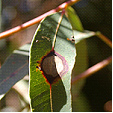 Eucalyptus species
Eucalyptus species
Eucalyptus species are infected by many fungal leaf spots such as (Mycosphaeralla species), (Hendersonia species) and (Monocheatia monochaeta). Generally leaf spots appear on the juvenile or new leaves causing brownish spots that enlarge and may have a purplish halo around the margin. Mature adult leaves are not normally infected and the trees rarely require control measures.
Fern species are infected by the leaf spot, (Alternaria polypodii). This fungus appears as brown circular or oblong spots that congregate along the margins of the pinnae causing the fronds to turn brown and die. It is spread by wind currents from plant to plant and control methods include removing infected fronds and maintaining a drier atmosphere.
Ficus species are infected by various fungal leaf spot including (Pseudocercospora species). Generally the fungal attack forms circular or irregular dark coloured spots on the leaves eventually causing them to fall prematurely.
Ficus elastica is susceptible to many fungal leaf spots including (Alternaria species), (Leptostromella elastica) and (Phyllosticta roberti).
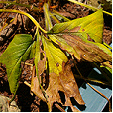
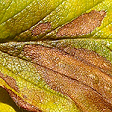 Strawberry
Strawberry
Fragaria x ananassa (Strawberry) is infected by the fungal leaf spot (Mycospharella fragariae). The mature leaf is initially infected with well defined brown spots that that turn light grey with red-purplish margins. As the spots merge they form large brown blotches and the leaf turns yellow then dies. This fungal attack normally occurs on plants in poor health and can be a serious problem early in the season seriously damaging stock.
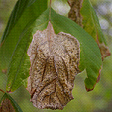 Fraxinus species
Fraxinus species
Fraxinus species are infected by the leaf spot (Gloeosporium aridum) giving the leaf a scorched appearance as large blotches appear from the margin or apex and turn brown with a papery texture. It is more prevalent during rainy periods and infected leaves fall prematurely. Collect and depose of fallen leaves otherwise control is not normally required.
Fuchsia species may be infected by the leaf spot (Septoria species) or ( Cercospora species), both form spots with dead centres and dark margins.
Gladiolus species are infected by Hard Rot or Leaf Spot (Septoria gladioli). On the corms reddish brown circular water soaked spots become large and sunken. These areas dry out and form obvious margins. The leaves may also have these symptoms but is not commonly seen.
Hemerocallis species are infected by several leaf spots including (Cercospora hemerocallis) and (Heterosporium iridis). These may be in the form of black spots or brownish spots that converge killing the leaf. Infected leaves should be removed and burnt.
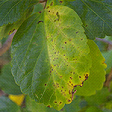 Hibiscus species
Hibiscus species
Hibiscus rosa-sinensis, Hibiscus syriacus and Hibiscus tiliaceus are susceptible to several fungal leaf spots including (Ascochyta abelmoschi), (Cerospora kellermanii) and (Phyllosticta hibiscina). All cause spotting or blotching of the leaf surface; remove and destroy infected parts.
Hydrangea species are infected by four fungal species including (Ascochyta hydrangeae), (Phyllosticta hydrangeae) and (Septoria hydrangeae).
Iris species are infected by several fungal leaf spots including (Alternaria iridicola) and (Macosphaerella species).
Iris species are also infected by the leaf spot (Didymellina macrospore) that forms greyish spots with brown water soaked borders and coalesce on the upper part of the leaf. This casual organism commonly occurs after flowering killing the leaves but will not infect the bulbs. The bulbs become weak over several seasons due to the decreased foliage.
There is also a Bacterial Leaf Spot (Bacterium tardicrescens) that is commonly mistaken as a fungal problem causing translucent spots that coalesce and involve the entire leaf. Normally found on Iris species.
Laburnum anagyroides is infected by the Leaf Spot (Phyllosticta cytisii). The leaf forms light grey spots with no definite margin and mature to brown. The black fruiting bodies appear as dots in the centre of the spot.
Leucanthemum species are infected by the leaf spot (Cerocspora chrysanthemi) and (Septoria leucanthemi).
Magnolia species are susceptible to many species including (Alternaria tenuis), (Mycosphaerella milleri) and (Phyllosticta species). Leaves generally turn brown from the apex or margins turning brown or spots appear on the leaf surface and leaves become yellow before withering and dieing. Normally the make the tree look poorly but have little effect on its growth. Control is not normally required.
Nerium oleander is susceptible to several fungal leaf spots including (Cercospora nerella), (Cercospora repens), (Gloesporium species) and (Phyllosticta nerii). Infected leaves should be removed but generally control is not required.
Nyssa sylvatica is infected by the leaf spot (Mycosphaerella nyssaecola) forming irregular purplish blotches.
Orchids such as Cattleya, Cymbidium, Cypripedium, Dendrobium, Epidendrum, Paphiopedilum, Phalaenopsis and Zygopetalum species are infected by several leaf spots including (Cerospora, Colletotrichum and Phyllosticta species). Normally forming dark or dead, circular or irregular areas on the leaves.
Palms such as Syagrus, Howea, Phoenix, Roystonea and Washingtonia species are infected by Leaf-scab (Graphiola phoeicis).
Palms such as Archontophoenix, Caryota, Chamaedorea, Cocos, Dypsis, Howea, Liculia, Linospadix, Livistona, Phoenix, Ptychosperma, Rhapis, Roystonea, Syagrus, Washingtonia and Wodyetia species are susceptible to several fungal leaf spots including;
(Bipolaris spp.), (Cylindrocladium spp.), (Colletotrichum spp.) and (Pestalotiopsis spp.).
Generally the circular leaf spots are brown and may have a yellow halo such as Palm Ring Spot (Bipolaris incurvata). They vary in size from small to large depending on the species. When a plant is healthy it recovers from attack, but heavy infections can defoliate, causing the collapse of the plant.
Palms are also infected by the Brachybasidium Leaf Spot (Brachybasidium pinangae). This fungus forms angular leaf lesions that produce fruiting bodies on the underside and is commonly found on Archontophoenix species.
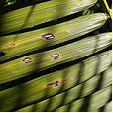
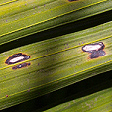 Archontophoenix cunninghamiana
Archontophoenix cunninghamiana
Passiflora species are infected with many types of leaf spot such as (Alternaria passiflorae).
Phoenix species are susceptible to False Smut (Graphiola phoenicis). This fungus forms yellow leaf spots that become hard with a raised with a blackish scab, which produces masses of powdery spores that are thread-like.
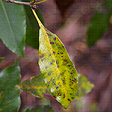
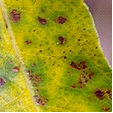 Pittosporum species
Pittosporum species
Pittosporum species are susceptible to the leaf spots (Alternaria tenuissima), (Phyllostica species) and (Cercospora pittospori). Circular or angular dark spots appear on the leaves and are surrounded by necrotic areas that are yellowish. Generally removal of infected leaves is adequate control.
Poa species and other cool season grasses are infected by Winter Fusarium Leaf Disease (Fusarium species), which causes small pale spots that are water soaked to appear on the leaves that turn red-brown. Infected leaves become bleached then wither and die, but the infection will not affect the crown or roots of the plant. It can be identified by pink, cotton-like mycelium and the plant prefers cold wet weather.
Populus species are infected by several fungal leaf spots including (Ciborinia bifrons, Ciborinia confundens), and (Mycosphaerella populicola).
Prunus species are infected by several leaf spots including (Cercospora circumscissa and Septoria ravenelii).
Pseudotsuga menziesii Douglas Fir is infected by the Leaf Cast (Rhabdocline pseudotsugae) Symptoms include the needles becoming yellowish at the apex and extending down the needle and spreading to others during moist spring weather turning them brown. Brownish scorched areas are noticeable on the tree from a distance. Control; is not normally required for mature trees but nursery stock may require spraying with a copper based fungicide.
Psidium guajava (Guava) is infected by (Glomerella cingulate). This fungus courses spots to appear on leaves and mummifies and blackens immature fruit or rots mature fruit. This fungus can devastate a guava crop.
Quercus species are infected by several types of leaf spot including (Cylindrosporium microspilum) and (Marssonina martini). These attacks tend top take place later in the season and normally not detrimental to the tree.
Rhododendron species are infected by a large variety of fungal leaf spots including (Cercospora rhododendri) and (lophodermium melaleucum)
Salix species are infected by several fungal leaf spots including (Ascochyta salicis) and (Septogloeum salicinum).
Senecio species are infected by the fungal leaf spot (Alternaria cinerariae) and (Cercospora species), forming dark rounded or angular spots.
Spiraea species are attacked by the fungal leaf spot (Cylindrosporium filipendulae).
Stenotaphrum secundatum (Buffalo) turf grass is susceptible to Grey Leaf Spot (Pyricularia grisea) in domestic and commercial situations devastating lawns. This fungal disease infects the stems and leaves with small brown lesions that enlarge rapidly forming grey-brown spots that have darker borders or surrounded by yellow chlorotic areas. This infection is commonly found on newly laid turf but will also infect established lawns. It is most prevalent during warm humid periods in soil with a high nitrogen level.
Syringa species are attacked by up to six species of leaf spot including (Cercospora lilacis) and (Phyllostica species).
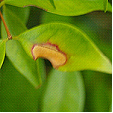 Syzygium species
Syzygium species
Syzygium species are infected by fungal leaf spots but normally control is not required.
Tagetes species are infected by the leaf spot (Septoria tageticola), which starts at the base and moves progressively up through the plant, covering the leaves in grey to black spots.
Trillium species are host to several leaf spots, including (Colletotrichum peckii) (Gloeosporium Trillii) (Heterosporium trillii).
Ulmus species are infected by many fungal leaf spots including (Gnomonia ulmea) and (Cercospora sphaeriaeformis).
Veronica species are infected by the leaf spot (Septoria veronicae). The symptoms include small violet to brown spots appear on the upper surface of the leaf and correspondingly yellowish brown on the underside. The spots converge forming a scorched shot-hole appearance and eventually death of the leaf.
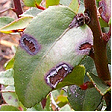 Vaccinium ovatum
Vaccinium ovatum
Vaccinium ovatum is infected by the leaf spot (Rhytisma vaccinii) and (Dothichiza caroliniana).
Vicia species are infected by the leaf spot (Erostrotheca multiformis), which forms greyish spots that enlarge and may defoliate the plant.
Wisteria species are infected by three fungal leaf spots (Phyllostica wisteriae), (Septoria wisteriae) and (Phomatospora wisteriae).
Non-chemical Control
Remove and destroy infected plant material and avoid overhead watering. When planting select infection resistant varieties. Practice crop rotation and add pot ash to the soil to decrease the plants venerability to the disease. Many species of fungus overwinter in fallen leaves, remove and destroy any litter under the plant.
Winter Fusarium Leaf Disease in Turf Grasses can be minimised by aerating the soil, reducing thatch and avoid excessive nitrogen in the soil.
Chemical Control
Protective fungicides such as zineb or copper oxychloride should be sprayed at the first sign of infection and cuttings should be sprayed as they start to grow.
Note
Always read the label for registration details and direction of use prior to application of any chemicals.
DISEASE
NAME
Grey Mould
Botrytis cinerea, B. elliptica
Description
Grey Mold, Shoot Blight, Petal Blight is a fungus problem that generally forms water-soaked spots that rot and produces greyish sclerotia (fungal resting bodies) on the surface. They can be found throughout the year on dead tissue and on live material during under ideal climatic conditions. Damaged areas such as a tear in a leaf or an opening made by an insect are more likely to be infected.
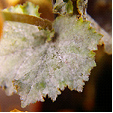 Grey Mold on Begonia species
Grey Mold on Begonia species
Image by B. Sonsie
Symptoms
The fungus attacks stems, leaves, flowers and fruit. In roses the fungus is primarily attacks the flowers producing pink rings on the petals and buds that become brown and rotten. This may extend down the peduncle to the stems causing dieback.
In other plants oval yellowish to brown spots appear, then the centre turns greyish and dries out and in humid weather the spots spread, joining up and infecting the entire leaf. This infection may also occur on the stems, and flowers may form abnormally or brown off and die.
When lettuce is infected it starts at the base causing a soft brown rot that may extend up the stem killing the plant, and pears flowers become infected then spreading to the fruit. This develops a sunken brown area that is soft and eventually is covered in grey powdery spores.
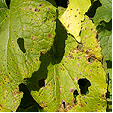
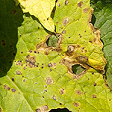 Botrytis Blight on Senecio cruentus
Botrytis Blight on Senecio cruentus
Botrytis Blight (Botrytis tulipae) infects leaves, flowers and stems with flecks of brown spots that merge to form light grey rotted areas that have brownish margin that may destroy stems. Affected areas are covered in a grey mould during humid conditions. The spores overwinter in dark brown sclerotia, which are found on the outer scales of the bulb or at the base of the stem in Tulipa species.
Grey Bulb Rot (Rhizoctonia tuliparum), which infects the bulbs of Tulipa species, attacking the base of the leaves and rotting the bulb. When bulbs emerge during spring in infected soil's they soon die off. The greyish mold tends to be dry.
Source and Dispersal
The sclerotia (fungal resting bodies) are found on dead plant material or in the soil and remain viable for many years. The spores are dispersed by wind or splashing water.
Favoured Conditions
It prefers cool moist climate with morning dew.
Affected Plants
Grey Mold attacks a wide range of plants including roses, fruit trees, pelargonium, ferns, grapes and cyclamens. Heliotropium , Amaryllis, Lilium and Hippeastrum species are also infected.
Agave species are infected by two fungal Leaf Blights (Botrytis cinerea) and (Stagonospora gigantea) that severely damage the leaves particular during wet periods or from excessive watering.
Cactus species are infected by soft rot or Grey Mould (Botrytis cinerea). Stems and pads turn are greyish with the upper surface, rotting then collapsing. The dieing tissue becomes slimy and is covered with grey mould that develops black sclerotia, which propagates the disease. It is more prevalent under warm humid conditions and control methods include removing infected parts and destroying them. In glasshouse situations ventilation should be improved and watering should be restricted to create a drier atmosphere.
Cereus species and other cacti are infected by Grey Mold causing the segments to become discoloured and as the rot progresses it tissue becomes slimy and collapses. Black sclerotia forms on the affected areas that are covered in grey mold during humid conditions.
Cuphea species are infected by this blight.
Orchids such as Cattleya, Cymbidium, Cypripedium, Dendrobium, Epidendrum, Oncidium, Paphiopedilum, Phalaenopsis and Zygopetalum species are infected by Grey Mold or Petal Spot (Botrytis cinerea). Petal and flower stalks form small brown spots.
Paeonia species are infected by Botrytis Blight (Botrytis paeoniae) causing the leaves and flowers to form a grey mold then suddenly collapse and die.
Pseudotsuga menziesii Douglas Fir is infected by Leaf and Twig Blight (Botrytis cinerea). This is a serious problem in wet conditions and is difficult to control.
Ribes species are attacked by Cain Blight (Botryosphaeria dothidea). The infection causes the cains to become blighted and wilt. To control remove damaged wood and destroy.
Non-chemical Control
Remove and destroy infected plants or fallen leaves. When planting, space as to allow good air movement to reduce humidity. Bulbs that are infected should be discarded and take care that bulb scales are removed from the soil to prevent further infection. Cactus and succulents that are infected should have the damaged areas cut out, or discard the entire plant. Under glasshouse conditions improve the ventilation and reduce watering to create a drier atmosphere.
Chemical Control
Under humid conditions spray regularly using a suitable fungicide such as thiram, mancozeb, dichloran and chlorothalonil.
Note
Always read the label for registration details and direction of use prior to application of any chemicals.
DISEASE
NAME
Leaf Nematodes
Aphelenchoides species
Description
These microscopic size soil borne nematodes attack leaves by entering through the stomates but are restricted by the veins. The nematode can resurface and move around the leaf in water, infesting other parts of the leaf.
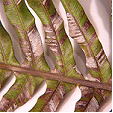
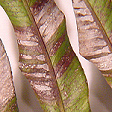
Leaf Nematode (Aphelenchoides ritzema-bosi) enters the plant when the stems and wet allowing the nematode swim to the stomates in the leaf. The leaf forms yellowish to brown spots that are contained by the veins but merge eventually turning the entire leaf brown then dieing. It infects greenhouse and outdoor Chrysanthemum and Penstemon species.
Stem Nematode (Ditylenchus dipsaci) enters through the stomates in young shoots and working upwards as thew stem grows causing the leaves to become malformed. Flowers fail to open, stems may grow sideways and the plant becomes stunted, dieing prematurely. The main host is Phlox species but not all are affected.
Symptoms
Infested fronds of ferns turn brown to black and may die prematurely. Other softer foliage plants such as Chrysanthemums form yellow spots initially that are constricted by veins. These areas become dark brown turning black in severs attacks with the leaf withering and collapsing.
Source and Dispersal
The nematodes remain active in plant material for up to 18 months. They are dispersed by infected plant cuttings or soil and travel along a film of water on the outside of the plant. They can also be dispersed by splashing water from the soil or from another plant.
Favoured Conditions
Humid cool conditions are preferred, as in after periods of rain or following overhead watering. They also prefer over crowded fernery stock.
Affected Plants
A wide range of plants are affected these include, Australian native plants in the Asteraceae family or Anigozanthos and Lophostemon species. Ferns such as Asplenium, Blechnum and Pteris species are also susceptible.
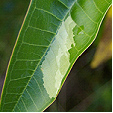 Plumeria acutifolia
Plumeria acutifolia
Many ornamentals, perennials, annuals, trees and shrubs are also attacked include;
Begonia, Bergenia, Chrysanthemum, Coleus, Cyclamen, Gloxinia, Impatient, Penstemon, Plumeria and Saintpaulia species.
Ficus and Philodendron species are occasionally attacked by the leaf nematode (Aphelenchoides fragariae) forming angular markings that are water soaked at first, and then turning brown appearing on the leaf surface.
Non-chemical Control
Heavily infected plants and infested parts should be removed and burnt. Infected plant parts may be immersed in hot water at 45 deg for up to 15 minutes. This can only be used in local infestations and the immersed period varies according to the species.
Be certain to propagate from uninfected plant material and avoid replanting with susceptible species.
Chemical Control
Application of a systemic pesticide such as Fenthion are effective, but must be used as soon as the damage appears and repeated fortnightly.
Note
Always read the label for registration details and direction of use prior to application of any chemicals.
Average Lowest Temperature : 10º C 50º F
USDA : 10, 11, 12
This USDA (United States Department of Agriculture) hardiness zone chart can be used to indicate a plant’s ability to withstand average minimum temperatures. However, other factors such as soil type, pH, and moisture, drainage, humidity and exposure to sun and wind will also have a direct effect on your plant’s survival. Use this chart only as a guide, always keep the other factors in mind when deciding where, when and what to plant.
A plant's individual USDA zone can be found in the Plant Overview.
Region of origin
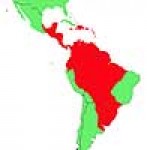
Central America, Caribbean, South America
Climate Description
Sub-tropical
This zone has ample rain with coastal breezes during summer and periodic high humid summer temperatures with mild winters.
Frosts and droughts rarely occur.
Plant growth
Tropical and some warm temperature native and exotic plants grow well.
| Dictionary | Growth Habit |
| Leaf Type | Botanic Flower Description |
| Leaf Shape | Flower Inflorescence |
| Leaf Arrangement | Fruit Type |
| Leaf Margin | Bark Type |
| Leaf Apex And Bases | Flower Description |